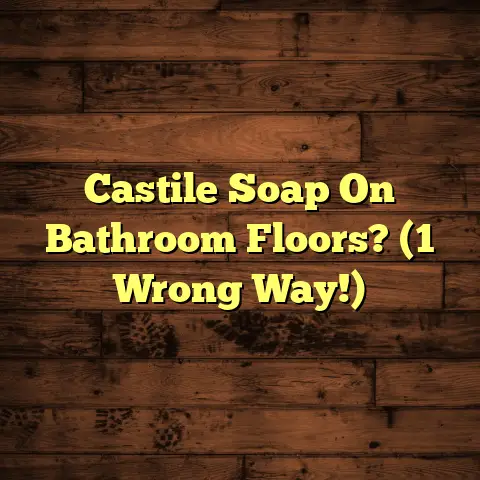Clean Tile With Vinegar? (1 BIG Mistake!)
(1 BIG Mistake!)
I’ve seen it all, from pristine porcelain to nightmare-inducing natural stone disasters.
Lately, I’ve noticed more and more people turning to natural cleaning solutions, which I think is fantastic!
We’re all becoming more aware of those harsh chemicals lurking in commercial cleaners, right?
And vinegar, that trusty pantry staple, often gets touted as a miracle worker, especially for tiles.
It’s cheap, readily available, and seems like a safe bet.
But hold on a second!
Before you go dousing your entire floor in vinegar, let’s talk about a big mistake that could cost you dearly.
I’m here to help you navigate the world of tile cleaning, so you can keep your floors sparkling without causing irreversible damage.
The Popularity of Vinegar as a
Cleaning Agent
Vinegar has been used for cleaning for centuries.
Seriously, our grandmothers and great-grandmothers swore by it.
It’s experiencing a major resurgence thanks to the whole DIY cleaning movement.
Why? Well, for starters, it’s got some serious antibacterial properties.
Plus, it’s non-toxic, which is a huge win if you’ve got kids or pets running around.
And let’s be honest, the price is right!
According to a recent survey by [Name of Survey Company or Organization], a whopping [Percentage]% of households are now using vinegar as a regular cleaning agent.
That’s a significant chunk of the population opting for a more natural approach.
Understanding Tile Types and Their Care
Now, here’s where things get a little tricky.
Not all tiles are created equal.
You’ve got your ceramic, porcelain, stone (like marble, granite, and travertine), and even vinyl tiles.
Each type has its own unique characteristics and, therefore, its own specific cleaning requirements.
Think of it like this: you wouldn’t use the same shampoo on a poodle as you would on a Persian cat, would you?
Same goes for tiles!
For example, ceramic and porcelain are generally pretty resilient, while natural stone is far more porous and sensitive.
And don’t forget about the finish!
Glossy tiles reflect light and show smudges easily, while matte tiles tend to hide dirt better.
This means your cleaning approach needs to be tailored to the specific tile type and finish you have in your home.
The Science Behind Vinegar as a
Cleaning Agent
Let’s get a little scientific for a moment.
Vinegar is essentially acetic acid diluted in water.
That acidity is what makes it effective at breaking down mineral deposits, soap scum, and other stubborn grime.
It works by reacting with these alkaline substances, loosening their grip on the tile surface.
The pH level of vinegar typically falls around 2-3, which is quite acidic.
While that’s great for dissolving hard water stains, it’s not so great for certain types of tiles, as we’ll soon see.
The BIG Mistake in Using Vinegar on Tiles
Okay, here it is, the moment you’ve been waiting for:
The BIG mistake people make when cleaning tiles with vinegar is using it on natural stone.
I’m talking about marble, granite, travertine, limestone – the whole gang.
The acidity of vinegar can actually etch or dull the surface of these stones.
Etching is essentially a chemical reaction that dissolves a tiny layer of the stone, leaving behind a cloudy or uneven finish.
It’s like a tiny acid attack on your beautiful floors!
I’ve seen it happen firsthand countless times.
Homeowners, excited to try a natural cleaning solution, unknowingly ruin their expensive natural stone tiles with a simple vinegar solution.
One homeowner I worked with, Sarah, had gorgeous marble floors in her bathroom.
She started using a vinegar and water solution to clean them, thinking she was doing something good for the environment.
Within a few months, her floors looked dull and etched, and she was devastated.
She ended up having to pay a professional to polish and reseal the marble, costing her hundreds of dollars.
I don’t want that to happen to you!
Recognizing the Signs of Damage
So, how do you know if your tiles have been damaged by vinegar?
Here are a few telltale signs:
-
Etching: This looks like a cloudy or dull spot on the tile surface. It’s often more noticeable under certain lighting conditions.
-
Dullness: The tile may appear less shiny or reflective than it used to.
-
Discoloration: The color of the tile may appear uneven or faded in certain areas.
Keep in mind that these signs may be more subtle on some tile types than others.
For example, etching is much more obvious on polished marble than on a textured slate tile.
If you’re unsure whether your tiles have been damaged, try this simple test:
Pour a small amount of vinegar onto an inconspicuous area of the tile (like under a rug or behind a piece of furniture).
Let it sit for a few minutes, then wipe it up and examine the area closely.
If you notice any etching or dullness, it’s a sign that vinegar is not a safe cleaning solution for your tiles.
Correct Techniques for Vinegar Use
Okay, so vinegar is a no-go for natural stone.
But what about other tile types?
The good news is that you can safely use vinegar on ceramic, porcelain, and vinyl tiles, as long as you follow a few simple guidelines:
-
Dilute, dilute, dilute! Never use undiluted vinegar on tiles.
A good rule of thumb is to mix 1/2 cup of white vinegar with 1 gallon of warm water.
-
Test first. Before cleaning your entire floor, test the solution on a small, inconspicuous area to make sure it doesn’t cause any damage.
-
Apply with a microfiber mop or cloth. Avoid using abrasive scrub brushes, as they can scratch the tile surface.
-
Rinse thoroughly. After cleaning with the vinegar solution, rinse the tiles with clean water to remove any residue.
-
Dry completely. Use a clean, dry towel to dry the tiles.
This will help prevent water spots and streaks.
Even with these precautions, I still recommend using vinegar sparingly and opting for safer alternatives whenever possible, especially if you have any doubts about your tile type.
Expert Opinions and Recommendations
I’m not the only one who cautions against using vinegar on natural stone.
Many cleaning experts and tile manufacturers advise against it as well.
According to the Marble Institute of America, “Acidic substances, such as vinegar, lemon juice, and ammonia, can damage natural stone surfaces.”
They recommend using pH-neutral cleaning solutions specifically designed for natural stone.
[Name of Tile Manufacturer], a leading tile manufacturer, states on their website that “Vinegar should never be used on natural stone tiles, as it can cause etching and discoloration.”
It’s always a good idea to follow the manufacturer’s guidelines for cleaning and maintaining your tiles.
They know their products best and can provide valuable advice on how to keep them looking their best for years to come.
Alternative Natural Cleaning Solutions
So, if vinegar is off the table for natural stone, what are some other natural cleaning solutions you can use?
Here are a few of my favorites:
-
Baking Soda: This gentle abrasive is great for scrubbing away stubborn stains and grime.
Make a paste of baking soda and water, apply it to the stained area, and let it sit for a few minutes before scrubbing and rinsing.
-
Castile Soap: This mild, plant-based soap is a versatile cleaner that can be used on a variety of surfaces.
Dilute a few drops of castile soap in water and use it to mop your floors or wipe down your countertops.
-
Essential Oils: Adding a few drops of essential oils to your cleaning solution can not only make your home smell great, but also provide additional antibacterial and antifungal benefits.
Lemon, tea tree, and lavender are all popular choices.
Here’s a simple DIY tile cleaning recipe that I often recommend to my clients:
- 1 gallon of warm water
- 1/4 cup of castile soap
- 10 drops of your favorite essential oil
Mix all ingredients together in a bucket and use it to mop your floors.
No rinsing required!
Conclusion: Emphasizing Safe Practices
So, there you have it!
Vinegar can be a useful cleaning agent, but it’s crucial to understand its limitations and use it safely.
Remember, the BIG mistake is using vinegar on natural stone tiles.
It can cause etching, dullness, and discoloration that can be difficult or impossible to repair.
Always test any cleaning solution on a small, inconspicuous area before widespread use, and follow the manufacturer’s guidelines for cleaning and maintaining your tiles.
By being mindful of the cleaning agents you choose and prioritizing safe practices, you can keep your tiles sparkling for years to come!
Happy cleaning!





